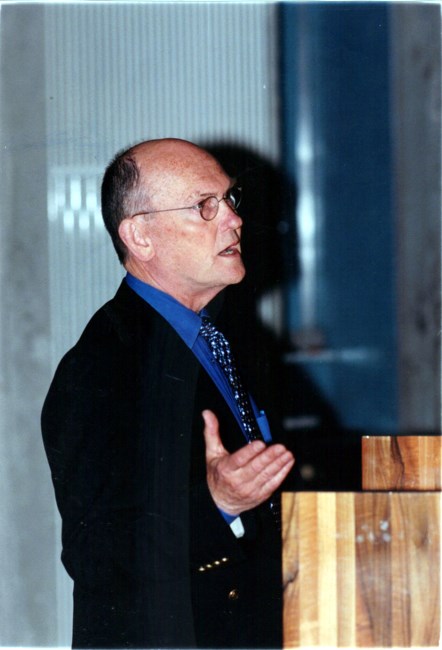
AVIS DE DÉCÈS
Roy Eugene Graham
20 août 1936 – 29 mai 2018

Internationally recognized architect and educator, Roy Eugene Graham, FAIA, died after a long struggle with cancer on May 29, 2018, after a stay at the University of Texas Southwestern Hospital in Dallas. He was born August 20th, 1936, in Shreveport, Louisiana, grew up in Natchitoches, Louisiana, and graduated from Louisiana State University in 1961, with a degree in Architectural Engineering. At LSU he was a member of Sigma Alpha Epsilon. In 1966, he received a Thomas Jefferson scholarship to attend the University of Virginia, where he received a Master’s Degree in Architectural History in 1968. He later pursued a doctorate in art history at the University of Texas in Austin.
Graham was a Captain in the US Army Reserve until 1968, when he began a teaching career at the University of Texas, teaching architectural history and design and developing the first historic preservation courses as part of an advanced design studio. This experience gave him a chance to combine architecture, engineering, history and preservation, which he dedicated himself to for the rest of his life.
Tenured in 1969 at UT School of Architecture, he went on leave for a decade to become the Resident Architect of the Colonial Williamsburg Foundation. In this capacity, he was the overall director of the departments of Architecture, Architectural Research, Landscape Architecture and Planning. He founded the department of Architectural Conservation and served as Administrative Officer of the Foundation. He was appointed a member of the Virginia Landmarks Commission and became active as Vice President of the Association for Preservation Technology (where he served 10 board terms), the Properties committee of the National Trust for Historic Preservation, the Octagon Committee of the AIA and the boards of the Victorian Society in America and the US Committee of the International Council on Monuments and Sites (ICOMOS). In 1979, Graham led a team of American preservation experts to the Soviet Union as part of the Nixon-Brezhnev cultural exchange created in 1973 and he was president of the ICOMOS General Assembly in Rome.
In 1975, Graham became the first full time director of the Historic Preservation Program at the University of Virginia. He returned to Austin in 1982 to begin the restoration of the Texas Capitol and to pursue architectural projects in his own firm. Five years later, he joined the faculty of the Catholic University of America in Washington, where he established an architectural conservation program and began working with the International Centre for the Study of the Preservation and Restoration of Cultural Property (ICCROM), as well as the Pontifical Commission for the Cultural Property of the Church. Projects of note included a conservation plan for the World Heritage Town of Lunenburg, Canada, and an inventory of cultural properties belonging to the Catholic Church in the US. Through ICCROM, he was a consultant on a conservation project at the Taj Mahal and the earthquake damaged St. Francis of Assisi Basilica in Italy. As a spokesman for ICCROM, he participated in meetings and gave talks around the world Including the UK, Spain, Finland, Bulgaria, Italy, Lithuania and Latvia. In the latter, he was the US and ICCROM voice in developing the Riga Charter on reconstructing historic sites. He became a fellow of the American Institute of Architects and US/ ICOMOS. In 1991, Graham was awarded a Senior Fulbright Professorship at the University of Ljubljana, Slovenia, which led to further Fulbright funding in order for him to establish the Consortium for Urban Conservation between Slovenia, ICCROM and CUA. After assisting in its formation, he became a member of the board of the National Center for Preservation Technology, serving as chair and remained active on the board until his death.
In 2003, Graham became director of the historic preservation program at the University of Florida College of Design, Construction and Planning. As the Beinecke-Reeves Distinguished Professor, he established a Master’s Degree Program and directed students in the College Doctorate program. His students produced neighborhood conservation plans for a number of historic Florida neighborhoods, as Graham became active on the board of the Florida Trust for Historic Preservation. That organization awarded him The Carl Weinhardt Lifetime Achievement award in 2011 and named a preservation education award for him in 2014. In 2013, he received the James Marston Fitch Preservation Education Lifetime Achievement Award from the National Alliance of Preservation Educators (NCPE). US/ICOMOS gave Graham the Ann Webster Smith award, their highest honor in international preservation, in Decembe,r 2015.
Roy was preceded in death by his father, Cecil Clare Graham, and his mother, Lise Coffey Graham, of Natchitoches. He is survived by his loving daughters; Heather Cunningham of Plano, TX, and husband James Darrell Cunningham, Elizabeth Graham of Carrollton, TX, and a grandson of whom he was very proud - Garrett Lane Graham of Denton, TX. His surviving siblings, Edward Graham and Cecilia Poissoi,t live in Natchitoches and his brother Stuart Graham lives in Highland Lakes, TX.
Graham was a member of the congregation of the Episcopal Church of the Incarnation in Dallas. There will be a Memorial Service held at the Church of the Incarnation located at 3966 McKinney Avenue, Dallas, Texas, 75024, on June 15, 2018, at 11:00am, with a reception to follow. Memorials may be made to the Roy Eugene Graham, FAIA, Student Preservation Award, Historic Preservation Program, College of DCP, 331 Architecture Building, PO Box 115701, Gainesville, FL, 32611-5701, or to the Murtagh-Graham Scholarship at US/ICOMOS. Burial will be private.
Montrez votre soutien
Envoyez Vos
Condoléances
Partager
L'avis De Décès
Obtenir les mises à jour
Services Précédents
Memorial Service
Partager l'avis de décèsPARTAGER
- RECEVOIR DES RAPPELS
v.1.17.0